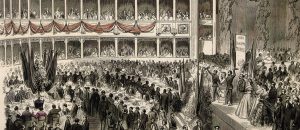The Imperial Yıldız Tile Factory (Yıldız Çini Fabrika-i Hümayunu) was established under the personal patronage of Sultan Abdulhamid II. Its purpose was to revive the vanishing Ottoman art of tiling and to create a domestic and national luxury brand capable of competing in quality with Europe’s famous Sèvres and Meissen porcelains. Just like [Link: what Hereke achieved in carpets…], the Yıldız Tile Factory was a “palace industry” initiative in the field of porcelain and ceramics. The unique vases, plates, and architectural cladding produced here are the most elegant and fragile evidence of the empire’s late-period design power, combining traditional Ottoman motifs with Western movements like Art Nouveau. [Link: Dolmahçe Palace Collections…]
Why a New Tile Factory?
By the end of the 19th century, classic Ottoman tile centers like İznik and Kütahya had lost their former brilliance, and production quality had declined. The porcelain needs of palaces and mansions were largely met by expensive products imported from Europe, especially from the Sèvres factory in France. Dissatisfied with this situation and following a sensitive policy regarding the encouragement of domestic production, [Link: Sultan Abdulhamid II…] ordered the establishment of a modern tile and porcelain factory as part of the Yıldız Palace complex in 1891. This was done both to end this external dependency and to restore prestige to Ottoman tile art. The goal was not only to meet the palace’s needs but also to create a “brand” of quality that could be exported to Europe.
Yıldız’s Technology and Art: The Synthesis of East and West
From the very beginning, the Yıldız Tile Factory was conceived as a center where technology and art merged.
European Technology: The factory’s technical infrastructure, kilns, and machinery were brought from France. Experts and chemists from the Sèvres factory were invited to manage the production process and train local masters. The latest Western technology was used for technical matters such as preparing and firing the porcelain paste (body).
Ottoman Art and Patterns: While the technical infrastructure was Western, the spirit and aesthetics of the products were entirely domestic. The factory’s design studio employed leading artists of the period, such as Osman Hamdi Bey, and international names like the architect Raimondo D’Aronco. In the patterns, traditional motifs taken from classical İznik and Kütahya tiles—such as the tulip (lale), carnation (karanfil), and hatayi—were skillfully combined with the curvy and floral forms of the Art Nouveau movement, which dominated late 19th-century European art.
Product Variety: The factory did not only produce decorative objects like vases and plates but also manufactured tile panels and architectural ceramic tiles for the decoration of palaces and public buildings (for example, the facade of the Istanbul Archaeology Museum).
The Claim to Rival Sèvres
The biggest goal of the Yıldız Tile Factory was to compete with the French royal porcelain factory Sèvres in terms of quality and aesthetics. This claim is clearly seen in the mark found underneath the produced works. Underneath Yıldız porcelains, the words “Yıldız” and sometimes “Constantinople” are found along with the crescent-star symbol. This was a stamp of origin and quality, just like Sèvres or Meissen. The produced works were sent as diplomatic gifts to foreign heads of state and exhibited at international fairs, announcing the Ottoman Empire’s claim in the fields of industry and art to the world. Notably, the gigantic Yıldız vases that Sultan Abdulhamid II presented as gifts to German Emperor Wilhelm II are the most magnificent examples of this competition.
The Fragility of an Imperial Heritage
The factory lost its former importance during the Committee of Union and Progress (İttihat ve Terakki) period and the early years of the Republic, eventually pausing production. However, today, it has resumed operation under the National Palaces administration and continues to produce historical patterns using modern techniques. The original Yıldız porcelains adorning the display cases of Dolmabahçe and Yıldız Palaces continue to exist as a priceless and fragile legacy, reflecting an empire’s late-period aesthetic quest, industrial initiative, and vision for creating a national brand.
Conclusion
In conclusion, the Imperial Yıldız Tile Factory (Yıldız Çini Fabrika-i Hümayunu) is the second major “palace industry” success story after Hereke, born under the patronage of Sultan Abdulhamid II. This factory, which fused Western technology with Eastern aesthetics, carried the claim of being a national alternative and rival to Europe’s luxury porcelain brands. The elegant works it produced are not merely decorative objects but are also valuable documents representing the final creative breath of an empire in the fields of industry, art, and design.















